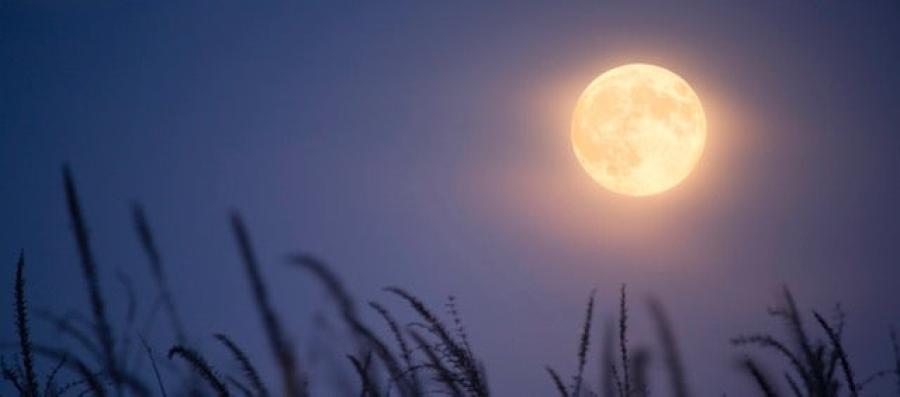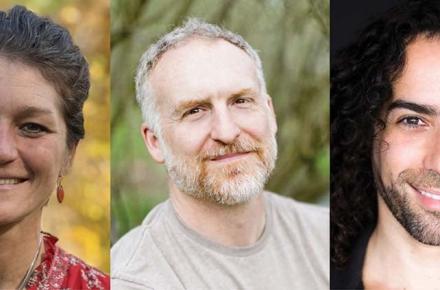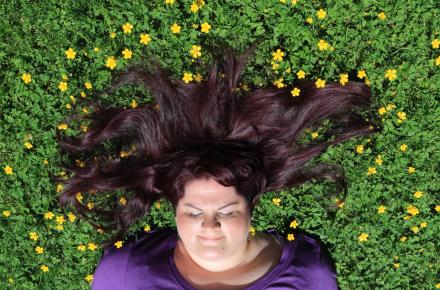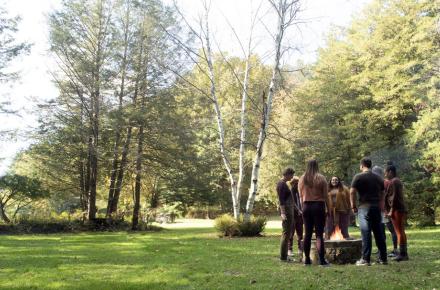What We Can Glean from the Harvest Moon

The Harvest Moon is the full moon that occurs closest to the fall equinox—christened thus because it provided light for farmers to work into the night, gleaning the gifts of the summer growing season. It's typically super-sized and extra low on the horizon, with a reddish glow. There's a bounty of traditional names for the September full moon: Full Corn Moon; “Moon When the Plums Are Scarlet,” from the Lakota Sioux; “Moon When the Deer Paw the Earth,” from the Omaha Native Americans; and “Moon When the Calves Grow Hair,” from the Sioux. The moon also rises earlier in the evening—during or near dusk—for a few days before and after the Harvest Moon, according to the Old Farmer’s Almanac, making it appear full for a few nights in a row.
As you're practicing Half Moon pose, Balancing Half Moon, or Moon Salutation by its glow, take a moment to reflect on the lessons we can glean from the Harvest Moon.
Understanding the science doesn’t make it any less awesome.
While we are naturally drawn toward myth and mystery, there’s also something satisfying about knowing the science that underlies natural phenomenon. For example, the burnished hue of the Harvest Moon is the result of its position (low on the horizon) and the density of the atmosphere there. According to EarthSky.org, the thickness of the atmosphere closer to the horizon scatters blue light, but lets red light pass through to our eyes—giving the Harvest Moon its yellow, orange, or reddish color.
There’s a comparison to be made here with the science of yoga. Yoga is a wellness practice that offers a host of evidence-based physical and mental benefits—and it can be a mystical and spiritual experience at the same time.
Beauty—and size—are in the eye of the beholder.
No one has definitively explained yet why the Harvest Moon looks so big as it looms over the horizon. It’s an optical illusion—called the Moon Illusion—that scientists and thinkers, going back to Aristotle and Leonardo da Vinci, have been trying to unravel for ages. It might have to do with the Harvest Moon’s proximity to the earth, making it appear larger in comparison to the smaller objects it’s closer to, like trees. Or it might be about the way our brains interpret depth of field, or the way they judge distance using the mechanism of focus.
What’s clear is that the moon has not changed size; it’s the way we see it that makes it appear larger. That’s an eloquent metaphor for our ability to shift the lens through which we experience the world.
Humans are meaning makers.
Since we’ve been around, we have been creating stories, projecting human attributes onto nature, and weaving tales that make sense of the universe—including the moon. In cultures worldwide, female idols represent the lunar sphere, Kripalu presenter Lara Tupper writes in her essay, “Moonstruck”: “In ancient Persia, she was Metra, the world mother. In Polynesia, she was the goddess Hina. Greeks called her Artemis, sister of Apollo. The Sioux name is Old Woman Who Never Dies.”
Stories have power. In fact, the practice of telling our stories is becoming increasingly recognized by Western medicine as an effective healing modality. Kripalu presenter Jillian Pransky describes narrative medicine this way: “It is not about fully understanding our story of life, but rather that we remain an open channel for that story to continually ebb and flow through us.”
We don’t have to lock ourselves into anything.
Along with making stories, humans like naming things. For example, the October full moon has also been called the Full Hunter’s Moon, Travel Moon, and Dying Grass Moon, among others. The other full moons during the year were also given many names, representing the many aspects of that time of year.
Take that as a reminder to embrace the many aspects of who you are, and not to take labels too seriously. As Walt Whitman wrote in “Song of Myself”:
Do I contradict myself?
Very well then I contradict myself;
(I am large, I contain multitudes.)
Here’s a list of full moon names from EarthSky.org.
Northern Hemisphere
January: Old Moon, Moon After Yule
February: Snow Moon, Hunger Moon, Wolf Moon
March: Sap Moon, Crow Moon, Lenten Moon
April: Grass Moon, Egg Moon, Pink Moon
May: Flower Moon, Planting Moon, Milk Moon
June: Rose Moon, Flower Moon, Strawberry Moon
July: Thunder Moon, Hay Moon
August: Green Corn Moon, Grain Moon
September: Fruit Moon, Harvest Moon, Full Corn Moon
October: Harvest Moon, Hunter’s Moon
November: Hunter’s Moon, Frosty Moon, Beaver Moon
December: Moon Before Yule, or Long Night Moon
Southern Hemisphere
January: Hay Moon, Buck Moon, Thunder Moon, Mead Moon
February: Grain Moon, Sturgeon Moon, Red Moon, Wyrt Moon, Corn Moon, Dog Moon, Barley Moon
March: Harvest Moon, Corn Moon
April: Harvest Moon, Hunter’s Moon, Blood Moon
May: Hunter’s Moon, Beaver Moon, Frost Moon
June: Oak Moon, Cold Moon, Long Night’s Moon
July: Wolf Moon, Old Moon, Ice Moon
August: Snow Moon, Storm Moon, Hunger Moon, Wolf Moon
September: Worm Moon, Lenten Moon, Crow Moon, Sugar Moon, Chaste Moon, Sap Moon
October: Egg Moon, Fish Moon, Seed Moon, Pink Moon, Waking Moon
November: Corn Moon, Milk Moon, Flower Moon, Hare Moon
December: Strawberry Moon, Honey Moon, Rose Moon
© Kripalu Center for Yoga & Health. All rights reserved. To request permission to reprint, please e-mail editor@kripalu.org.
































